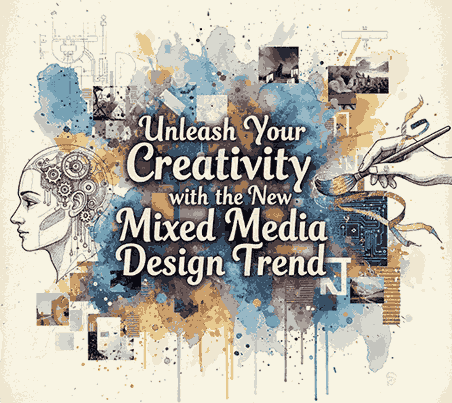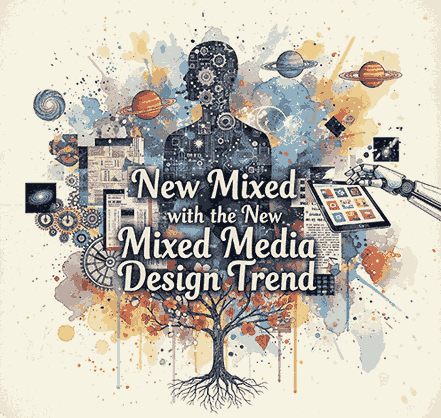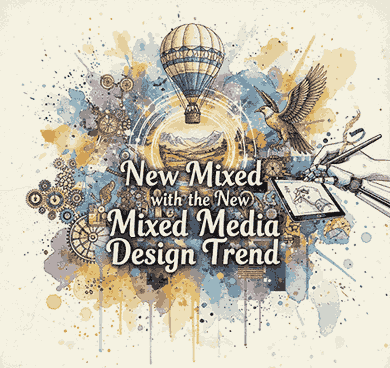
Table of Contents
- Introduction
- What Is the Mixed Media Design Trend?
- Why Mixed Media Is Rising in 2025
- Key Techniques & Elements in Mixed Media Design
- How to Use Mixed Media Trend in Branding & Visuals
- Font Choices That Elevate Mixed Media Designs
- Examples & Use Cases
- Common Pitfalls & How to Avoid Them
- Conclusion
- References
1. Introduction Mixed Media Design Trend
The Mixed Media Design Trend is swiftly becoming one of the most exciting directions in graphic design for 2025. By merging traditional art techniques—like collage, painting, textures—with modern digital tools, designers are creating visuals that feel both handcrafted and futuristic. In this article, we’ll explore why mixed media is capturing attention, how to use it effectively, and which fonts can complement its layered aesthetic.
2. What Is the Mixed Media Design Trend?
Mixed media in graphic design refers to combining multiple materials or techniques—physical and digital—into a single visual piece. These may include paper textures, hand-drawn illustrations, torn edges, ink splatters, photography, digital overlays, and more.
Rather than sticking to one medium, mixed media embraces layering and juxtaposition. The result is a rich, tactile composition that feels experimental and expressive.

3. Why Mixed Media Design Trend Is Rising in 2025
3.1 Demand for Authenticity
With AI-generated content proliferating, audiences crave visuals that feel human, raw, and imperfect. The mixed media trend brings back the “handmade” touch in a digital world.
3.2 Visual Complexity & Engagement
In a crowded digital feed, static flat graphics struggle to grab attention. Mixed media layers textures, depth, and variation—making visuals more memorable.
3.3 Trend Forecasts
Many trend reports for 2025 highlight mixed media as a key aesthetic in editorial design, branding, and digital campaigns.
4. Key Techniques & Elements in Mixed Media Design Trend
To get started, here are techniques designers often mix:
- Collage & cutout layering — overlapping textures, magazine cutouts.
- Hand-drawn illustrations — sketches, ink strokes.
- Textured backgrounds — paper, fabric, grunge textures.
- Digital overlays & blending modes — using Photoshop or Illustrator to combine.
- Photographic elements — combine photos with illustration or texture.
- Typography integration — custom fonts overlaid, warped, or masked.
- Color contrast & transparency — play with opacity to reveal layers.
The goal: create harmony between these elements so the design feels intentional, not chaotic.
5. How to Use Mixed Media Trend in Branding & Visuals
Here’s how brands and creatives can apply the trend:
- Brand identity & logos: include mixed textures or hand-drawn accents around clean logos.
- Social media posts & ads: layer photos with grunge textures and custom type overlays.
- Editorial layouts: magazines or webzines can use torn edges, overlays, and typographic layers.
- Packaging & product design: mixed textures and collage elements make packaging feel tactile.
- Web & UI design: subtle textures or hand-drawn details on headers, hero sections.
When applying, always maintain balance—mixed media works best when the core message is still clear.

6. Font Choices That Elevate Mixed Media Design Trend
Because mixed media visuals are rich and complex, font choice must complement without clashing. You’ll want fonts that can hold up against textures and layered visuals. Here are excellent mockup examples from your catalog:
- Aeromove Font — sleek and modern, pairs well as headlines over textured backgrounds.
- Kidsway Font — playful, illustrative style can harmonize with collage or hand-drawn elements.
- Glow Curly Font — decorative and expressive, ideal for focal text in mixed media layouts.
Tips: Use one expressive font for major titles, and pair with a neutral sans-serif or serif for body text to preserve readability.
7. Examples & Use Cases
- Editorial covers combining photo, torn paper texture, and custom script titles.
- Social media campaigns overlaying ink splashes and hand-drawn lines over product shots.
- Album covers or poster art mixing collage, paint strokes, and typography.
- Brand launches using mixed media visuals to convey uniqueness and artisanal quality.
Many contemporary brands are already adopting the trend, mixing digital and analog elements to tell richer visual stories.
8. Common Pitfalls & How to Avoid Them
- Visual overload: too many textures or layers can confuse the viewer.
- Readability issues: textures may obscure text—always ensure enough contrast.
- Style mismatch: combining elements that clash (e.g. hyper-realistic photo + cartoon textures).
- Overreliance: use the mixed media accent, not for every element.
- File size & performance: complex visuals can bloat files—optimize assets.
Testing designs at smaller scales (mobile) helps catch readability or layering issues early.
9. Conclusion
The Mixed Media Design Trend is an exciting frontier in 2025 design: it offers visual richness, emotional authenticity, and layered storytelling. When applied skillfully—with balanced typography, layered techniques, and optimization—it can elevate your branding and visual content to new heights.
Pairing along with strong font choices like Aeromove, Kidsway, and Glow Curly can help you harness this trend with clarity and style.
References
- Zeka Graphic – Mixed Media in Graphic Design: Complete Guide
- Venngage – 10 Graphic Design Trends That Will Dominate 2025
- Logovent – 10 Game-Changing Graphic Design Trends for 2025
